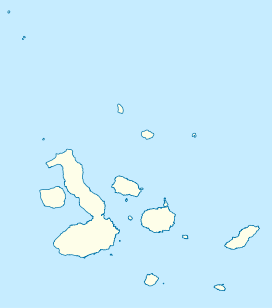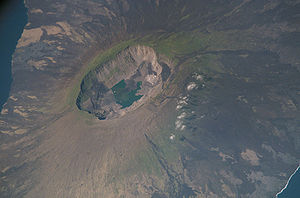- Fernandina Island
-
Fernandina 
Fernandina Island (centre) and Isabela IslandElevation 1,476 m (4,843 ft) Location Galápagos Islands, Ecuador Coordinates 0°22′S 91°33′W / 0.37°S 91.55°WCoordinates: 0°22′S 91°33′W / 0.37°S 91.55°W Geology Type Shield volcano Last eruption April 28, 2009 Fernandina Island (formerly known in English as Narborough Island, after John Narborough) is the third largest, and youngest, island of the Galápagos Islands. Like the others, the island was formed by the Galápagos hotspot. The island is an active shield volcano that has been erupting since April 11, 2009.[1]
On the 14th of February 1825, while anchored in Banks Bay, Captain Benjamin Morrell recorded one of the largest eruptions in Galapagos history at Fernandina Volcano. His ship escaped to safety and his account of the event was preserved.
Fernandina has an area of 642 km² (247.9 miles2)and a height of 1,476 meters (4,842 feet), with a summit caldera about 6.5 km (4.0 mi) wide. The caldera underwent a collapse in 1968, when parts of the caldera floor dropped 350 meters. A small lake has intermittently occupied the northern caldera floor, most recently in 1988.
Due to its recent volcanic activity, the island does not present much plant life and has a mostly rocky surface. Visitors to Fernandina Island will be taken to see only the outskirts of the crater for safety reasons. Punta Espinoza is a narrow stretch of land where hundreds of marine iguanas gather in large groups on black lava rocks. The famous Flightless Cormorant inhabits this island as well as penguins, pelicans and sea lions. Two types of lava flow can be observed, ʻaʻā and pāhoehoe. Mangrove forests also abound on the island.
Contents
April 2009 Eruption
The southern flank of the volcano La Cumbre had a fissure eruption that generated flows, which subsided within hours. This is the youngest and westernmost island of the archipelago. It was named in honor of King Ferdinand of Spain, who sponsored the voyage of Christopher Columbus. Isla Fernandina supports wildlife that could be threatened by the April 2009 burst of volcanic activity, according to rangers at Galapagos National Park. As the island has no human residents, however, no settlements were endangered. Park rangers and a passing tourist boat initially observed the volcano at 10:00 p.m. local time on April 10, 2009. A sparse human population in the western reaches of the Galapagos Islands means that volcanic activity is not always observed or reported as soon as it starts. The seismic station at Puerto Ayora, on the nearby island of Santa Cruz, recorded no earthquakes associated with this eruption.
See also
References
External links
- "Fernandina". Global Volcanism Program, Smithsonian Institution. http://www.volcano.si.edu/world/volcano.cfm?vnum=1503-01=.
- Special Report: Volcano Erupts on Fernandina Island. Charles Darwin Foundation
- Fernandina
- Benjamin Morell and the Galapagos Eruption of 1825
- Eruption on Isla Fernandina NASA Earth Observatory
Main islands Baltra Island · Bartolomé Island · Darwin Island · Española Island · Fernandina Island · Floreana Island · Genovesa Island · Isabela Island · Marchena Island · North Seymour Island · Pinzón Island · Pinta Island · Rábida Island · San Cristóbal Island · Santa Cruz Island · Santa Fe Island · Santiago Island · Wolf IslandMinor islands Categories:- Galápagos Islands
- Mountains of Ecuador
- Shield volcanoes
- Volcanoes of Ecuador
- Active volcanoes
- Volcanic calderas
- Hotspot volcanoes
- Uninhabited islands of Ecuador
Wikimedia Foundation. 2010.



